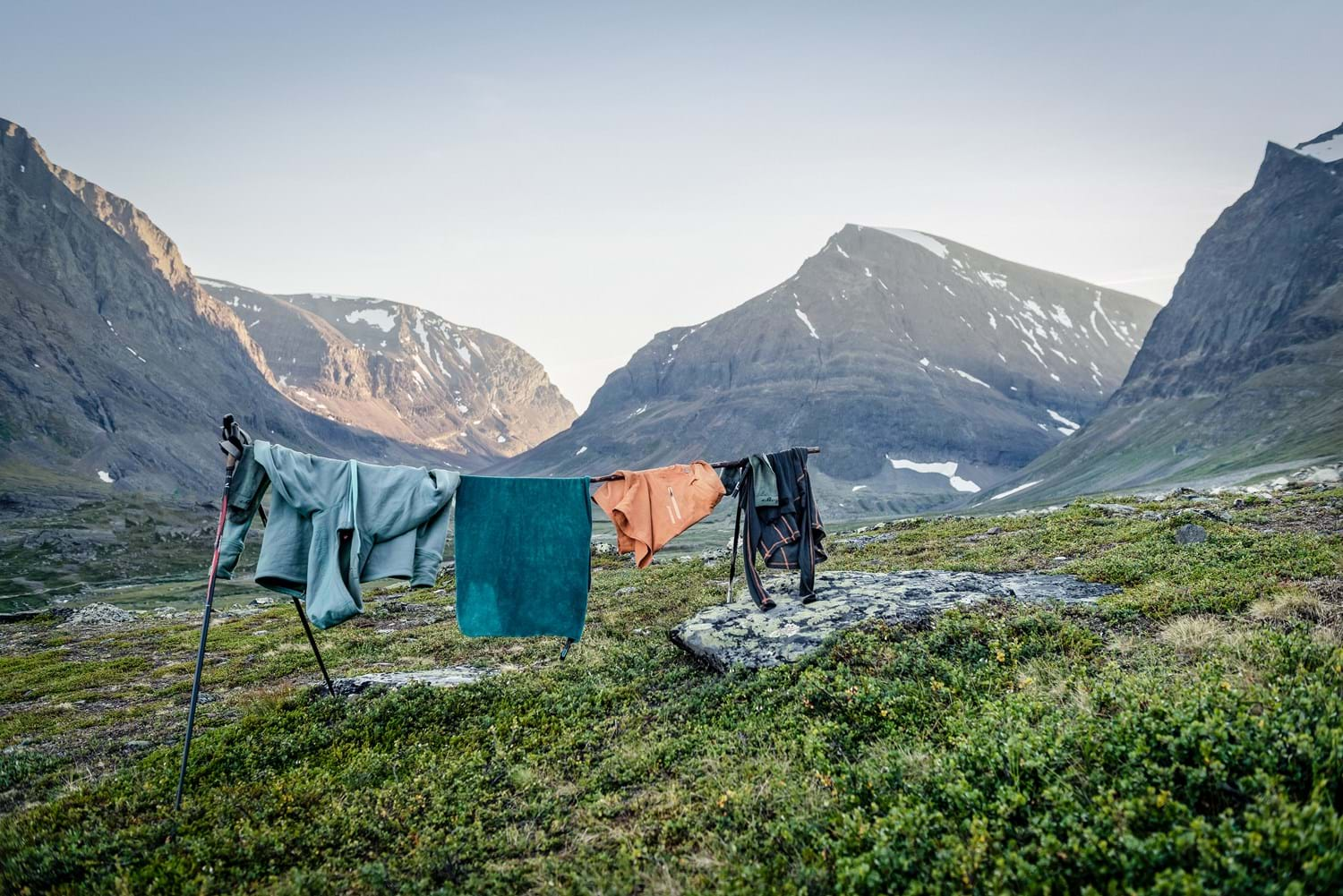
Taking care of technical clothing is not difficult and if you wash it in the right way. Many underestimate the fact that the life of the garments can be significantly extended.
Blog don't Lie has been fighting for unsuspected times to reduce the environmental impact with deeds. Choosing brands that have the right approach to the subject.
We want you to take your favorite garments on more adventures and at the same time make a contribution to improving the environment around you.
What more can you ask for?
An important part of the total environmental impact of a textile product is related to how long the product can be used before it wears out, how it has been cared for and finally what happens when it can no longer be used for its original purpose. A good starting point is to choose clothing that is durable, timeless in design and made from recycled and/or recyclable fibers. So, how you take care of your clothes while wearing them also makes a big difference. Not only for the environment, but also for the performance of your products.
Houdini Sportwear is perhaps the clearest example of how to think and act in this direction is correct.

"Reducing how often we use our washing machines is a big win for our clothes and the environment."
There are many environmentally certified detergents and cleaners available that reduce the impact of washing on the environment. How full a washing machine or dryer is plays the biggest role on energy, water and detergent consumption. In small households it can be difficult to fill a machine and the washing instructions for many garments recommend "wash separately".
In-store, we're available for washing tips and how Houdini can help you repair your clothes, return them for laundering or buy laundry supplies.

"Usually we wash our clothes too much. Lightly soiled clothes can be aired instead."
Avoid using fabric softener. They have a negative impact on the performance of garments and on our environment. The fabric softener leaves a coating on the fibers of the garment, which affects the moisture transport and breathability of the garment. Some of the substances contained in the fabric softener are difficult for nature to break down and harm aquatic living organisms. They also contain perfumes and substances that can cause allergic reactions.
Make sure the zippers are zipped up and the Velcro fasteners closed when washing. This will minimize the risk of fabrics catching on sharp edges during the wash and starting to pill. A laundry bag will protect all fabrics and clothing from tearing or stretching in the washing machine. It will also limit microfiber losses in the washing process, which means preventing microplastics from entering rivers and oceans. You can buy the GuppyFriend wash bag in store.
Most outerwear, especially outer layers and insulating garments, have DWR treatments - durable water repellent. The purpose of these is to make the outer fabric water resistant. When it wears off after a few seasons, the outer fabric of your outer layer will start to get wet even though the membrane will still block water from passing through the garment. When this happens, you can reapply the DWR with a washing product or spray.
We usually wash our clothes too much. Fresh air is good for both people and clothes. It's often said that we spend more time doing laundry today than we did in the 1940s, when washing machines were very rare.
Wool is a fantastic material with natural resistance to bacteria and dirt. Therefore, wool does not need to be washed after each use. In fact, frequent washing has a negative effect on the properties of the wool and wears out the garment unnecessarily. Instead, air your wool garments to reduce water usage, save energy, and make your garments last longer.
Use a laundry bag to protect your clothes. When cleaning the bag and filter in the machine, be sure to clean it and throw the fluff in the bin.
Delicate machine wash at max 30 degrees, preferably with a wool programme.
If you can, use wool detergent. Otherwise, use delicate and environmentally certified detergents and make sure you use the right amount. Choose a pH-neutral, enzyme-free detergent.
Avoid bleach and alkaline substances that increase the pH value. Also avoid enzymes such as protease or amylase as these can break down wool, which give this material its natural performance properties. This also applies to silk.
Avoid fabric softener. As well as being harmful to our environment, they have a negative impact on the performance of the garment, mainly on moisture transport and breathability.
Do not tumble dry.
Shape the garment after washing and hang it out to dry.
Wool is a natural, living material that can be formed with relative ease. Therefore, store your woolen items folded and not on a hanger to prevent your garments from losing shape.

"Wool is a fantastic material with natural resistance to bacteria and dirt. Therefore, wool doesn't need to be washed after each use."
When washing clothes made from synthetic fabrics, using a laundry bag becomes even more important: it prevents microplastics from entering rivers and oceans.
Air your clothes instead of washing them to save water, energy and to make clothes last longer.
Use a laundry bag to protect your clothes and to prevent fibers from escaping. When cleaning the bag and filter in the machine, be sure to clean it and throw the fluff in the bin. Never rinse it in water as we don't want the fibers to end up in lakes or oceans.
Machine wash cold.
Use environmentally certified mild detergents and make sure you use the right amount.
Avoid fabric softener. It is harmful to the environment and weakens the performance of functional clothing.
Do not tumble dry. This exposes both the garment and the environment to unnecessary wear and tear. However, most polyester clothing dries quickly.
Hang dry.
Our padded garments are made with synthetic insulation from Primaloft. The advantages of a synthetic padding compared to down are many: you don't have to dry the garment with balls to regain its shape, it dries faster and it doesn't smell when it's damp.
Air your clothes instead of washing them to save water, energy and to make clothes last longer.
Use a laundry bag to protect your clothes and to prevent fibers from escaping. When cleaning the bag and filter in the machine, be sure to clean it and throw the fluff in the bin. Never rinse it in water as we don't want the fibers to end up in lakes or oceans.
Machine wash cold.
Use environmentally certified mild detergents and make sure you use the right amount.
Avoid fabric softener. It is harmful to the environment and weakens the performance of functional clothing.
Hang dry. Just remember to heat the garment after washing to reactivate the water repellent surface of the outer fabric. Use a drying cabinet, tumble dryer or iron. Be sure to monitor the heat so the garment doesn't melt.
"Remember to introduce heat to the garment after washing to reactivate the water resistant surface of the fabric."
Softshells or single layer shells are garments with a water-repellent surface, but without a membrane.
Air your clothes instead of washing to save water, energy and to make clothes last longer. Make sure you wash your shell if it has been used in salt water or has become very sweaty or dirty as this weakens the performance of the garment. They can reduce the breathability of the fabric and damage the water-repellent surface. Dirt can also allow moisture to escape through the fabric.
Use our wash bag to protect your garments and to prevent fibers from escaping. When cleaning the bag and filter in the machine, be sure to clean it and throw the fluff in the bin. Never rinse it in water as we don't want the fibers to end up in lakes or oceans.
Machine wash cold.
Use environmentally certified mild detergents and make sure you use the right amount.
Avoid fabric softener. It is bad for the environment as it does not break down and weaken the performance of functional clothing.
Hang dry. Just remember to heat the garment after washing to reactivate the water repellent surface of the outer fabric. Use a drying cabinet, tumble dryer or iron. Be sure to monitor the heat so the garment doesn't melt.
You can reapply or strengthen the water repellent treatment with a wash or spray when needed. Always use an organic DWR.

Houdini's design philosophy is to provide products that last. Products which, due to their quality, style and functionality, simply do not need to be replaced.
This is why the company offers a lifetime product warranty. Every part of a Houdini product is designed to last its entire life. If a part fails at an earlier stage, they repair or replace it. If you happen to damage a Houdini product, we are happy to provide the same repair service at a reasonable price.
The idea is to extend the life of the product in every possible way and to make sure your Houdini companion travels with you for as long as possible.
Once your product has worn out, please remember to hand it in so we can recycle it into another great Houdini product!
Shop our Houdini garments HERE.

